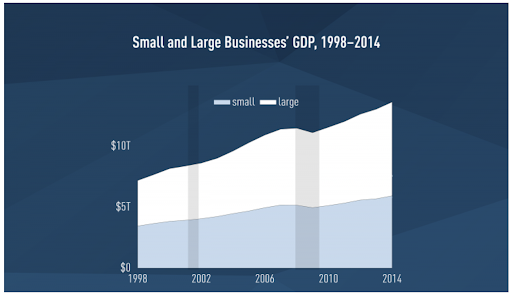
The Ultimate Small Business Guide: How to Get Started
We put together this small business guide because starting your own business can be a daunting task. Some people are scared of the uncertainty involved, others are afraid of the risk. But the reality is that the decision to start a business, whether it’s, is not only rewarding but essential for economic growth.
According to a recent report, small businesses create two-thirds of new jobs, drive U.S. innovation, and account for 44 percent of U.S. economic activity.

Image from U.S.Small Business Association Office of Advocacy
There are also plenty of personal benefits to starting your own business. You’ll have more job security and control over your future. Plus you’ll have the ability to grow your company and over time scale it to meet demand. it up to meet demand. And when you do begin making profits, you’ll have fewer limitations on your financial gains than in a typical 9-5.
For those that have been considering starting a business, we’ve put together the ultimate small business guide on how to start and grow your company.
Step 1: Brainstorm Your Product or Service Ideas
This step is all about brainstorming potential ideas. Brainstorming is an important step. It helps you identify if your idea is something worth pursuing or not. Brainstorming also gives you a chance to evaluate the possible risks and pitfalls of pursuing this idea. It also helps you generate creative ideas for what could be done with your concept in order to make it more appealing for your target demographic.
Here are some basic things to consider when you start forming your business idea:
- Identify what product or service you want to launch
- How will it be different from your competitors?
- Who is your target audience?
It’s also important to note that there is no such thing as a perfect idea, and it’s important to be open-minded when coming up with new ideas.
You’ll want to find a business idea where both your passions and skills are utilized. If you’re not passionate about what you’re doing, then it’s going to be hard for you to succeed!
The next step in our small business guide is assembling your dream team.
Step 2: Build Your Team
A small business is a business that has fewer than 500 employees, but you’ll likely start with just a handful of people. To keep your small business alive, you need the right team behind you to drive growth.
As the owner of a small business, you are responsible for overseeing all aspects of the company. Every decision made has an impact on the company’s bottom line, so it’s important to be knowledgeable about all aspects of your industry, competitors, and environment.
That being said, you don’t want to get caught up in being the “jack of all trades” and stretch yourself too thin.
If you don’t have any marketing experience or expertise, hiring someone who does will save you heaps of time and energy.
Next, you’re going to want to map it all out.
Step 3: Write A Business Plan
Writing a business plan is an important step for any business, regardless of the size. A good business plan should include information about your company’s:
- Company description
- Mission/values
- A market analysis (SWOT)
- Goals
- Financial objectives
- Marketing & sales strategy
- Risks
The market analysis section should include a formal SWOT analysis that takes into consideration the strengths and weaknesses of your company along with opportunities and threats that you might face. Based on your SWOT analysis, you will be able to evaluate the risk more clearly.
The financial section of your business plan should include information about projected revenues and expenditures as well as detailed budgets for the next 3-5 years.
The marketing section should outline how the company plans to attract customers including pricing plans for its services or products. This should also include an outline of any other marketing & sales strategies that you intend to use to reach audiences outside its target audience.
Now, the only thing left is to get the ball rolling.
Step 4: How To Fund Your Startup Without VC Funding
There are many different ways you can fund your startup without VC funding. You could get a bank loan, raise funds through crowdfunding, get backing from family and friends, or approach investors.
Another common way to fund your small business is by ‘bootstrapping’. You use your own funds to start your business, then grow it slowly. There are many different ways in which you can do this including:
- Starting a blog or website
- Taking care of customer support
- Consulting
- Developing apps
- Reaching out to influencers to help promote your product or service
There are also several affordable tools you can use to help you organize and grow your business. Zellim is a productivity app intended to supply small businesses with the same powerful tools large corporations use, but at a price, you won’t need funding for. Zellim plans start at $14.99/mo and include features project management, video conference, chat & voice channels, and automated appointment calendar.
With the advent of new technologies and increased access to information, the possibilities for startups are endless. The only thing you need is a good idea and a lot of energy! And if you’ve been sitting on a business idea for a while, we hope this small business guide was helpful for you.